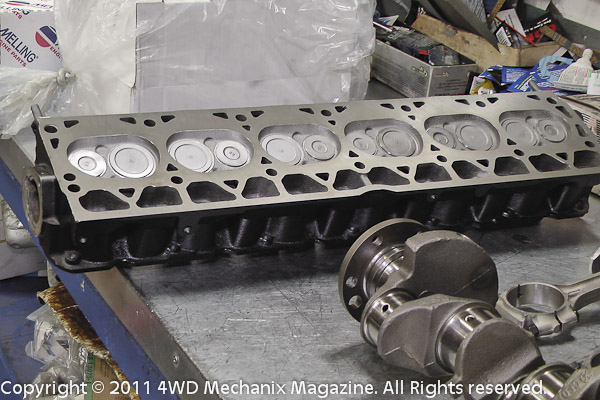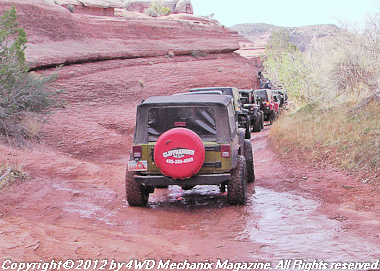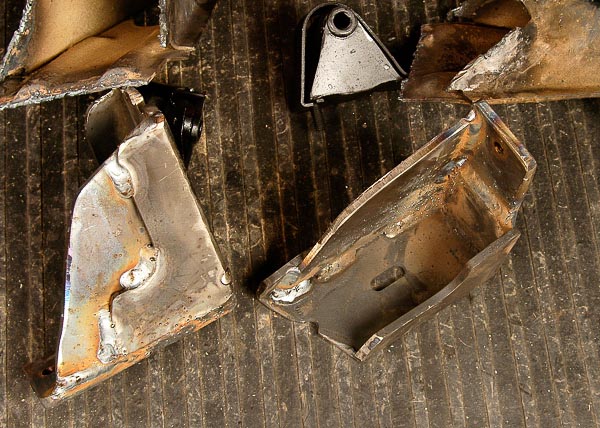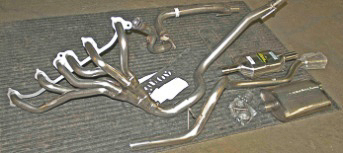Enjoy the many detailed, traditional ‘Q&A’ exchanges in these article columns…’Q & A’ has now moved to open, interactive forum discussions. Visit the forums, you’ll want to join—for free!
Have technical questions about your Jeep 4×4, popular 4WD truck, SUV, ATV, UTV or dirt motorcycle—or welding and metal fabrication? The 4WD Mechanix Magazine ‘Tech and Travel’ Forums now feature enthusiastic discussions and input from members and our staff—including comments from Moses Ludel…
Want to discuss your technical and outdoor interests with like-minded enthusiasts? Check out the 4WD Mechanix ‘Tech and Travel’ Forums! Click here for a guest visit to the forums!

Computing 4.6L Stroker Inline Six Compression Ratio
From: Nick
Sent: Tuesday, November 13, 2012 8:38 PM
To: 4WD Mechanix Magazine
Subject: stroker CR
I have been searching for a stoker recipe and have now watched ML’s vid series with Tony Hewes 3 times. The engine in the vids is said to have a 8.7:1 CR. This suits me perfectly. My question: There was no talk of adding vol. to the piston dish or heads combustion chamber. And the deck hg. is almost 0.0 with .045″ quench. Is the 8.7:1 SCR obtained by the cam duration? Or did I miss something?
Thanks
Nick D
From: 4WD Q & A
Sent: Wednesday, November 14, 2012 6:59 AM
To: ‘Nick’
Cc: Tony Hewes
Subject: RE: stroker CR
Hi, Nick…The SCR math includes the new stroke length. Envision the added stroke, 0.030” overbore and original 4.0L combustion chamber size/volume. Tony shared that these specific pistons produce that 8.7:1 compression, and the crowns are configured for the 4.2L crankshaft and 4.0L head. Note that these are not stock 4.0L pistons.
As a comparison, Mopar’s 4.7L produces 9:1 with the forged pistons that they use. That engine has a 0.060” overbore 4.0L block, 4.2L crank and an iron 4.0L head.
Does this help clarify? If not, please let me know, and I’ll get the specifics from Tony for the actual piston crown design and dish volume…Your question on SCR encourages another video discussion: How to determine SCR with a given bore/stroke, deck height, piston crown/dish, head gasket thickness and combustion chamber volume…
Regards,
Moses Ludel
From: Nick D.
Sent: Wednesday, November 14, 2012 4:48 PM
To: ‘4WD Q & A’
Subject: RE: stroker CR
Thank you Moses. I have looked at many stroker recipes in the past months and the vast majority have CR’s +9.0:1. This is higher than I wanted so I was excited to hear TH talk with you about the build in the vid. The unknowns from the vid were combustion chamber volume and the amount of resurfacing that was done to the head. Since the combustion chambers were not altered I will proceed assuming that if I use a head requiring a min. of cleanup I will end with a SCR below 9:1.
Thanks again
Nick
From: 4WD Q & A
Sent: Wednesday, November 14, 2012 7:46 PM
To: ‘Nick’
Subject: RE: stroker CR
Reasonable, Nick, especially if you use Tony’s recommended piston choice. The head was a stock 4.0L with typical remanufacturing and, as you note, milled simply to flatten. This would be a minimal cut and likely not impact the CR any more than the difference between head gasket thicknesses from various manufacturers.
The 4.0L head design is fairly resistant to knock/detonation. If you wind up in the 8.5-8.8:1 CR range, you’ll be quite pleased with the performance. Let me know what injectors you find useful. There’s a lot of scuttle about 302/5.0L Ford type, which can vary from 19-24 lbs. rating. My gut is that you need true 24 pound, let me know your findings.
I offer tuning tips and footnote facts at the magazine site’s coverage of the 4.6L stroker build. Check it out.
Regards,
Moses
From: Nick D.
Sent: Thursday, November 15, 2012 5:18 AM
To: ‘4WD Q & A’
Subject: RE: stroker CR
I am absolutely using the Silv-o-lite 229chc piston . I’m a long way from injectors and though I have a budget my build plan includes new Bosch 24# injectors. This build kicked off yesterday when I scored a $150 donor 258 from a 1976 CJ from which I’ll harvest my rods and crank. I wish I was close enough to Hewes Racing to have Tony do my machining but practicality dictates I find a reliable shop in CO for that. I typically use your magazine for reference on Jeep topics.
Thanks, again,
Nick
Thanks, Nick…Please let me know how the Bosch 24# injectors work and your engine parts build list. You’re at the high country like us, so your Jeep is a good benchmark. Let me know how the PCM likes these injectors and please furnish the actual Bosch part number…When you compile the build details, let me know more about your Jeep, tire size, weight, axle gearing, etc.
I talked with Tony yesterday, and we’re doing a sequel HD video on SCR and DCR for the magazine viewers. Likely, we’ll shoot the video by mid-December. This is a topic that needs detail, there’s much confusion online…
Regards,
Moses

New Member of the Jeep Wrangler Community!
—–Original Message—–
From: david c.
Sent: Thursday, November 15, 2012 6:04 PM
To: 4WD Mechanix Magazine
Subject: Howdy from Texas, upcoming Wrangler owner…
Hi, Moses,
I’m a passionate photographer, and after my 3rd visit to Big Bend in West Texas, I’ve decided I need a Jeep in my life to get out to the canyons and deep desert. Your site is a great resource for all of us.
I’m a former submarine driver, disabled vet (not serious, lots of folks far more injured than I). Will be borrowing a standard Sahara for a desert visit this December just to get my feet wet, then am thinking seriously about one of the Moab or Rubicon guided trail rides for the best possible training/experience.
Don’t think I’m going to become a dedicated rock crawler, but do think the Rubicon is about as perfect for me (at least at the start) as I can possibly need. Reading your site, maybe I’ll wind up making another choice, though.
Anyway, cheers, and maybe I’ll meet you on the trail some day!
dave c.
Hi, Dave…Great to hear your commitment to the Jeep lifestyle, and thanks for the kudos on the magazine.
The HD video coverage of Wheelers for the Wounded should clarify the Rubicon challenges. You might consider running with that group this coming fall, it would be a chance to ride the Rubicon with experienced drivers, without plunging your own rig into the fray.
I’m here with any tech advice, and the growth in HD video at the 4WD Mechanix Video Network provides a more graphic sense for the Jeep thing…My Jeep Owner’s Bible (Bentley Publishers) has encouraged many folks, its most recent (3rd) edition covers through the TJ Wrangler era, the XJ Cherokee and the beam front axle WJ Grand Cherokee. The book offers a solid orientation to wheeling and the Jeep paradigm.
Best,
Moses

Jeep YJ Wrangler Improved Air Intake for 2.5L or a 4.0L Swap?
From: Ryan S.
Sent: Saturday, September 22, 2012 4:43 PM
To: 4WD Mechanix Magazine
Subject: 2.5l tbi cold air intake
While looking at you 2.5l tbi troubleshooting page, I saw that the top picture showed an AEM cold air intake. However, I don’t believe AEM makes an actual kit, so I was wondering how you installed it. I know the factory air box has all sorts of hoses attached to it, so what do you do with them when you remove it? Any help with this will be greatly appreciated.
Ryan S.
Ryan, I talked to my son-in-law Kevin about the air intake, as it was on the engine when I swapped the 4.0L inline six engine into that chassis. He had it custom fabricated from a Honda V-6 application kit and shares that the air intake worked well on the 2.5L and also on the upgrade 4.0L six.
Kevin takes the unit off for Smog Check, although the system has a California E.O. number for use on the Hondas (possible argument for passing smog, though doubtful by the letter of the CA smog laws). The 4.0L six has Mopar’s K&N intake, so that’s not an issue. Kevin claims the Honda system does improve performance, even over the Mopar EFI intake air.
Trust this helps. It would take fabricating to make the air intake fit. The hoses would be a straightforward consideration…
Moses
More conversation…

From: Ryan S.
Sent: Sunday, September 23, 2012 9:05 AM
To: 4WD Q & A
Subject: Re: 2.5l tbi cold air intake
Ok, if I were wanting to swap in a 4.0L would the motor simply bolt up or would I have to install new motor mounts?
On Sun, Sep 23, 2012 at 9:24 AM, 4WD Q & A wrote:
Hi, Ryan…I installed the 4.0L with Mopar EFI/MPI in place of the 2.5L. The frames are different on 2.5L models and those with either a 4.2L or 4.0L inline six. In this case, you must fabricate motor mounts and carefully locate the transmission/transfer case, drivelines and motor mounts, plus install a new radiator, which also requires upgrade with the 4.2L/4.0L version and shroud. See this page at the magazine where I share photos of that 4-to-6 cylinder engine mount changeover:
https://www.4wdmechanix.com/MIG-Welding.html
Some adapter pieces were from an Advance Adapters’ universal mount kit. I created the rest, including the reinforcement plates, and welded the setup properly into position with MIG technique…Alignment is crucial for proper engine height and driveline angles.
Moses

Manifold Swaps for the 4.0L Inline Six?
From: M.T.
Sent: Sunday, April 29, 2012 11:55 AM
To: 4WD Q & A
Subject: 1998 TJ Wrangler 4.0L
Hi Moses,
I recently acquired a stock 1998 Jeep TJ Wrangler and would like to get more power and fuel economy out of its 4 litre engine. What could I expect from an intake manifold swap to a ’99 up 4.0 intake manifold, a header, aftermarket exhaust system, and an AEM cold air intake? What are the impacts on fuel economy and seat of the pants performance?
M.T.
Hi, M.T.…Worth noting, the factory 4.0L manifolds offer marginal gains if any. All of the OE header pipe/exhaust manifolds have a knack for cracking, the superceded number is at least better than the ’98 OE exhaust manifold. Purchasing that Mopar header/manifold new would be money better applied toward a Borla header with low-restriction Borla crossover connecting pipe.
In my experience, Borla’s header has stamina that justifies the cost. I cover the Borla header with Random Technology’s low-restriction cat at the magazine: https://www.4wdmechanix.com/How-to-Installing-a-Random-Technology-High-Performance-Catalytic-Converter.html . The Borla header and connector pipe replaced a cracking ’99 XJ Cherokee exhaust manifold/header. Without the Random Technology cat described, the performance gain would be marginal. I noted a large difference in performance with the cat in this article, better than the restrictive stock cat or even the earlier Random Technology cat. Expected life of these high performance cats is around 45K-50K miles. Borla’s header will last much longer than the stock header/manifold.
Below are some U.S. (presumably Canadian as well) TJ Wrangler part numbers from a 2008 Mopar catalogue. They reflect updates and superceded numbers to that point. The currently available 1998 replacement exhaust header/manifold is actually the 1999 design. As you note, the 4.0L intake manifold change is 1999, which corresponds to a redesign of the cylinder head. The 1999-2006 TJ 4.0L engines use different cylinder head designs and valve types than the pre-1999 4.0L head. The ‘99 intake manifold may fit (gasket is the same as ’98); however, I’m unaware of any performance increase with that manifold if mounted on a ’98 cylinder head. Beware: Manifolds and cylinder head designs differ around the threaded ports for sensors. Compare intake manifolds before plunging…the ’99-up manifold may lack necessary ports. I would not change intakes.
There are more significant performance gains elsewhere, M.T. The heavy push now is the 4.6L stroker six build, which can be done with a range of approaches and budgets. (I cover this within the magazine.) For a stock 4.0L in good condition, some owners claim gains from an aftermarket throttle body spacer, air intake changes (AIR or K&N) and a header like the Borla with a low-restriction crossover pipe and aftermarket cat. I do not recommend an open-faced AIR or K&N air filter for deeper water fording.
Note that these are factory part numbers, not casting numbers…
1998 TJ 4.0L Six:
53010237 MANIFOLD, Intake
53010238 GASKET, Intake/Exhaust Manifold
04883385 MANIFOLD, Exhaust
1999 TJ 4.0L Six:
04854197AA MANIFOLD, Intake
53010238 GASKET, Intake/Exhaust Manifold
04883385 MANIFOLD, Exhaust
2000 TJ 4.0L Six:
MANIFOLD, Exhaust (two-piece)
53010196 Front
53010199 Rear
04854197AA MANIFOLD, Intake
04854038 GASKET, Intake/Exhaust Manifold
Cylinder Head Changes from 1998 to 2000—Note that these are factory part numbers, not casting numbers…
1998 Cylinder Head: 53020622AC HEAD, Cylinder
Valves: 33003515 VALVE, Intake, Standard
04637537 VALVE, Exhaust, Standard
1999 Cylinder Head: 53020622AB HEAD, Cylinder
Valves: 53010512AA VALVE, Intake, Standard
53010513AA VALVE, Exhaust, Standard
2000 Cylinder Head: 53010334 HEAD, Cylinder
Valves: 53010512AA VALVE, Intake, Standard
53010513AA VALVE, Exhaust, Standard
Regards,
Moses Ludel

Stroker Build with a BBD Carburetor and Motorcraft Distributor?
From: Theodore A.
Sent: Tuesday, April 10, 2012 8:04 AM
To: 4WD Mechanix Magazine
Subject: 4.6 stroker
does the 4.0 block have a distributor boss i am looking into building a 4.6 i have a 90 yj carburetor and distributor will this work thanks ted
Hi, Ted…The 4.0L uses a distributor through 1999 and still offers the boss for the 2000-up cam position sensor as a means to drive the oil pump. (Fortunately for your purposes, the 4.0L came into production in ’87, while the 4.2L was still in production. AMC kept the distributor location and same oil pump driving provision.)
Measure a 4.0L distributor or cam position sensor and compare with your 4.2L distributor…Presumably, you will use a 4.0L cylinder head with the 4.0L block on the stroker buildup. (The 4.0L head also fits a 4.2L block by plugging off the excess cooling ports to use with the 4.2L block. There are also head bolt centering washers required on some 4.2L block applications that use the 7/16″ bolts. 4.0L head bolt diameters are 1/2″. See HESCO or Tim Weaver’s website for details. There is also info at the Jeep Strokers site.
If you use the 4.0L head, make sure the intake manifold ports will align with the 4.0L head ports and gasket: There are two head designs for the 4.0L, high and low port design. Select the right head for your intake manifold or consider Clifford Performance’s carburetor intake manifold for the later (’91-up) hi-port 4.0L head.
The combustion chamber design of the 4.0L (both port types) is better than the 4.2L, so there is no point to keeping your 4.2L head, especially since the cooling passageways differ…The Clifford manifold would require an adapter to the BBD Carter carburetor; most consider a Weber (shown above) or small four-barrel replacement carburetor…not a bad idea with the 4.6L displacement. Review the Clifford online catalog/website for ideas.
Keep me posted…
Moses Ludel
What’s a 4.7L Stroker Six Long-Block Upgrade?
Hi, Moses! My 1990 Wrangler’s 258 six is finally worn out. I installed Mopar’s EFI kit several years back and that made a huge improvement, on and off-road. Everyone talks about the 4.7L stroker engine, and you did an article that helped me understand the upgrade. Do you have personal observations on the actual performance gains? I will have to pull a number of items from the existing motor to build a 4.7L. Ideally, I want a replacement long-block that will mate to the existing motor mounts and the AX15 transmission and bell housing.
—Mike S.
I had the chance to drive Mopar’s XJ Cherokee with the 4.7L six at Moab. We drove in sand and high range 4WD. The dramatic increase in low-end torque becomes immediately clear. This is neither a 4.0L nor a 4.2L but rather an improvement over either of those engines. Although Mopar declines to offer dyne results (as these are often challenged and reflect a variety of tuning variables), here are credible comments that, based upon my experience, sound plausible. They come from thoughtful contributors and are courtesy of http://www.ajeepthing.com/stroker-motor.html. (See that website for further details and author credits.)
“I transformed a junkyard 4.0L short block plus a pile of parts into a rip-snorting torque monster with a displacement of 4563cc (4.6L)…My stroker engine’s producing a calculated 265 hp @ 4900 rpm and 325 lb-ft @ 3500 rpm. At least 278 lb-ft (1.0 lb-ft/cubic inch displacement) is available from 1500-5000 rpm, and over 300 lb-ft is on tap from 2000-4500 rpm. The difference in performance over the old modified 4.0L is very noticeable, particularly from 1500-4000 rpm where I need it most. Performance wise, this stroker engine has hit the bull’s eye!”
”A Hesco 4.7L stroker dyne’d 267 hp @ 4700 rpm and 332 lb-ft @ 3400 rpm at the flywheel…Another Hesco built 4.6L stroker did even better on the engine dyne, producing 269 hp @ 4800 rpm and 340 lb-ft @ 2500 rpm.”
“Limeyjeeper built the 4.0L engine from his ’99 WJ into a 4.6L stroker engine using this kit. It produced 210.5 hp @ 4800 rpm and 262.4 lb-ft @ 3800 rpm on the chassis dyne. Assuming a 20% drivetrain loss (RWD with automatic transmission), that’s 263 hp and 328 lb-ft at the flywheel…Specs are the same as a medium-buck stroker except for 0.030″ overbore, Ford Motorsport 24 lb/hr injectors, stock intake, and a 62mm [throttle body].”
The last engine likely produced even more power than assumed; 20% is a conservative adjustment for rear wheel versus flywheel horsepower with an automatic transmission. These results sound compelling.
A 4.0L block like the 4.7L will work with your bellhousing, spacer plate and AX15. Yes, the long-block will fit, including the provision for your 4.2L bolt-on motor mount brackets. The Mopar crankshaft follows the stroke of the 4.2L but has later 4.0L pilot dimensions. A retrofit pilot bearing and your original flywheel will bridge the conversion. (See Hesco or Advance Adapters for the bushing. If you use a stock, refreshed 4.2L crankshaft with the 4.0L block, the pilot is no issue.)
AMC’s coup was the use of bolt-on front engine brackets in addition to a common block bellhousing pattern for the 4.2L and 4.0L engines—and V-8s for that matter. The 258/4.2L CJ uses different bolt-on brackets than either the 4.2L or 4.0L YJ or the 4.0L TJ application. (An XJ Cherokee falls into this mix, too.) Your early YJ brackets should fit the 4.0L/4.7L block.
Mopar does not address the issue of chassis or transmission fitment. The Mopar marketing approach is a direct replacement for three model applications of the 4.0L; each is a fuel-injected 1991-up model.
On some applications, the oil filter mount and adapter requires use of the earlier (4.2L) pieces or a changeover to the 4.0L type. The key here is the by-pass valve design and thread type for the filter (U.S. or metric threads). CJ era differs from later YJ/TJ/XJ types…You will likely wind up using your 258 pieces (adapter, by-pass valve and stand) with an oil filter for the YJ 258/4.2L six.
Be sure there is a by-pass/anti-drain back valve in place as required. These parts must be compatible with the oil filter type. You do not want the engine and filter to drain back oil upon shut-off as this will cause a dry start each time you crank the engine. Dry starts cause premature main and rod bearing failure. If you need part numbers for matching, compatible pieces, let me know.
Regards,
Moses
